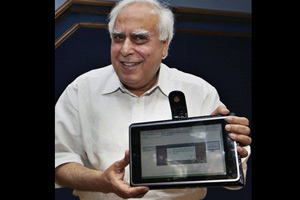NEW DELHI: Here we go again! India’s Human Resource Development Minister Kapil Sibal has “launched” a $35 computer, evidently a “dream project” of his.
The touchscreen, Linux-based device looks iPad-inspired, but we know little about how it works.
 It emerged from a student project with a bill of material adding up to $47, a price that the minister wants to bring down to $10 “to take forward inclusive education”. It promises browser and PDF reader, wi-fi, 2GB memory, USB, Open Office, and multimedia content viewers and interfaces.
It emerged from a student project with a bill of material adding up to $47, a price that the minister wants to bring down to $10 “to take forward inclusive education”. It promises browser and PDF reader, wi-fi, 2GB memory, USB, Open Office, and multimedia content viewers and interfaces.
Will it die a quick death within this year, or a painful, government-funded one over the next two? I fear the latter. Project Sakshat even has a busy website so it looks like a project well under way.
Remember the Rs 10,000 personal computer, the Simputer, the $100 laptop from the Massachusetts Institute of Technology, the NetPCs from a host of companies and India’s so-called $10 laptop? How many flops and failures will it take to convince governments — and brave, but misled companies — to get these facts of life tech, products, and life?
You don’t launch products until you have a product to launch. Else it’s vapourware. The Indian government is building up a good track record of vapourware, from $10 laptops upward. Apple, for in sharp contrast, for instance, launches with a million units ready to sell, and midnight queues outside.
You don’t show prototypes unless they are working ones with running apps, backed by a clear game plan to build up a vendor and apps network, and a clear design and specifications — and, preferably, a bill of materials.
It isn’t about the hardware — it’s about the application and the applications (apps) ecosystem. What will it be used for? Who will make those apps? Where’s the developer community? Where is the road map for hundreds of applications?
Apple had it all when it launched the iPhone and the iPad. Product design isn’t one-off. It’s an ongoing process, with software updates, improvements, upgrades, and most of all, growing apps support. You can make a working laptop, but it’s no trivial task maintaining it through the life cycle of the product, ensuring support, firmware and hardware upgrades, and new versions.


